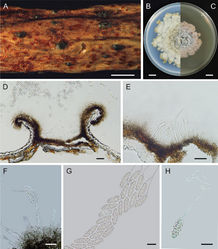Nagrajomyces fusiformis
| Notice: | This page is derived from the original publication listed below, whose author(s) should always be credited. Further contributors may edit and improve the content of this page and, consequently, need to be credited as well (see page history). Any assessment of factual correctness requires a careful review of the original article as well as of subsequent contributions.
If you are uncertain whether your planned contribution is correct or not, we suggest that you use the associated discussion page instead of editing the page directly. This page should be cited as follows (rationale):
Citation formats to copy and paste
BibTeX: @article{Zhuo2022MycoKeys93, RIS/ Endnote: TY - JOUR Wikipedia/ Citizendium: <ref name="Zhuo2022MycoKeys93">{{Citation See also the citation download page at the journal. |
Genus: Nagrajomyces
Name
Nagrajomyces fusiformis C. L. Hou & L. Zhuo sp. nov. – Wikispecies link – Pensoft Profile
Etymology
The epithet fusiformis refers to fusoid conidia.
Type
China, Yunnan province, Lijiang, Yulong, 26°40'55"N, 99°54'01"E, alt. 2762 m, on dying twigs of Rhododendron vellereum Hutch. ex Tagg., 20 June 2021, coll. C.L. Hou, M.J. Guo, H. Zhou (holotype CAF 800050).
Diagnosis
This new species differs from N. dictyosporus and N. laojunshanensis by fusoid to elongate-fusoid conidia with pointed ends, usually 1-septate and smaller.
Description
Conidiomata solitary, pycnidial, irregularly plurilocular, subepidermal in origin, immersed at first, then becoming erumpent through the periderm of the host, 545–554 μm diameter, 520–546 μm high, peridium dark brown, 47.0–67.5 μm thick. Conidiophores ampulliform, smooth, hyaline, multiguttulate, 12–29 × 2.0–3.5 μm (x̄ = 19 × 3 μm, n = 20). Conidia fusoid to elongate-fusoid, 1-septate, cells equal, smooth, hyaline to pale brown, 13.5–19.0 × 3–4 μm (x̄ = 16.5 × 3.5 μm, n = 20), with a whip‑like appendage at the tip of each conidium, 30–77 μm (x̄ = 51 μm, n = 20) in length (Fig. 4). Sexual morph not observed.
Additional specimen examined
China, Yunnan Province, Lijiang, Laojunshan, 26°37'56"N, 99°43'30"E, alt. 3873 m, on dying twigs of Rhododendron vellereum, 20 June 2021, coll. C.L. Hou, M.J. Guo, H. Zhou (BJTC 1773).
Notes
Nagragomyces fusiformis differs from other species of Nagrajomyces by narrower and 1-septate conidia.
Original Description
- Zhuo, L; Guo, M; Wang, Q; Zhou, H; Piepenbring, M; Hou, C; 2022: A new study of Nagrajomyces: with two new species proposed and taxonomic status inferred by phylogenetic methods MycoKeys, 93: 131-148. doi
Images
|


